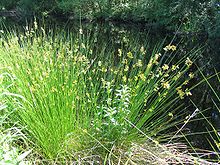Juncus effusus
| Juncus effusus | |
|---|---|
 |
|
| Scientific classification | |
| Kingdom: | Plantae |
| (unranked): | Angiosperms |
| (unranked): | Monocots |
| (unranked): | Commelinids |
| Order: | Poales |
| Family: | Juncaceae |
| Genus: | Juncus |
| Species: | J. effusus |
| Binomial name | |
|
Juncus effusus L. |
|
| Synonyms | |
|
|
Juncus effusus, with the common names common rush or soft rush, is a perennial herbaceous flowering plant species in the family Juncaceae. In North America the common name soft rush also refers to Juncus interior.
Juncus effusus is nearly cosmopolitan, considered native in Europe, Asia, Africa, North America, and South America. It has naturalized in Australia, Madagascar, and various oceanic islands.
It is found growing in wet areas, such as wetlands, riparian areas, and marshes. In the United Kingdom it is found in purple moor-grass and rush pastures and fen-meadow plant associations.
Juncus effusus grows in large clumps about 1.5 metres (4 ft 11 in) tall at the water's edge along streams and ditches, but can be invasive anywhere with moist soil. It is commonly found growing in humus-rich areas like marshes, ditches, fens, and beaver dams.
The stems are smooth cylinders with light pith filling. The yellowish inflorescence appears to emerge from one side of the stem about 20 centimetres (8 in) from the top. In fact the stem ends there; the top part is the bract, that continues with only a slight colour-band marking it from the stem. The lower leaves are reduced to a brown sheath at the bottom of the stem.
Five subspecies are currently recognized:
Juncus effusus can be differentiated from the rarer Juncus pylaei by the number of ridges on the stem. Juncus effusus has 30 to 40 ridges and J. pylaei has 10 to 20.
...
Wikipedia
